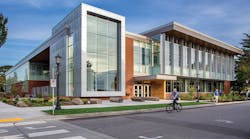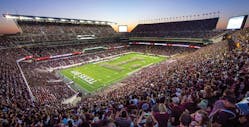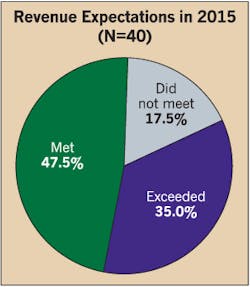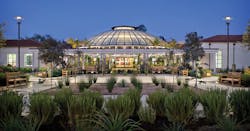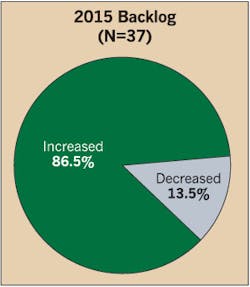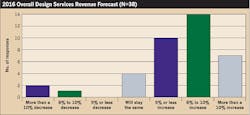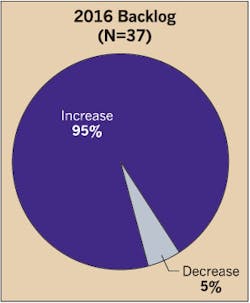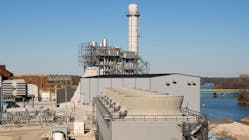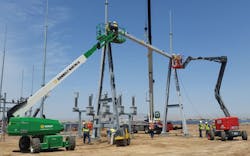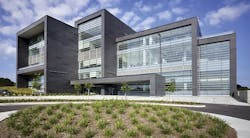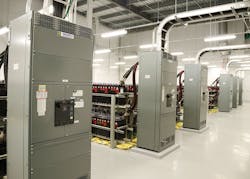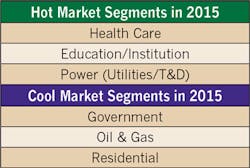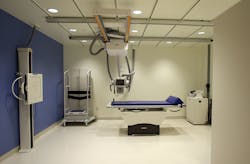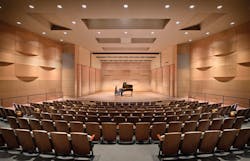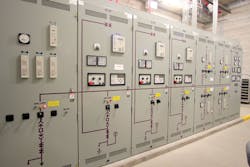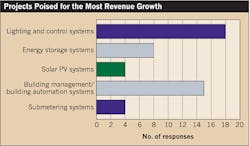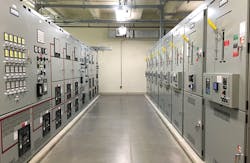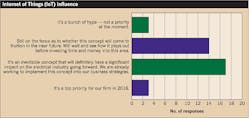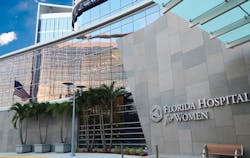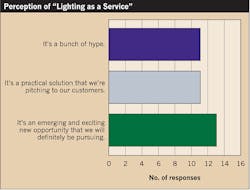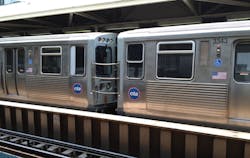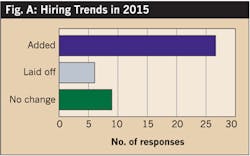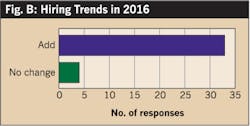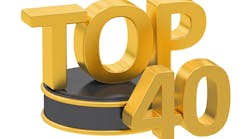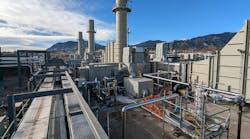The firms on this year’s Top 40 Electrical Design Firms list appear to have enjoyed another banner year in 2015, boosted by a largely favorable, if still uncertain, macroeconomic climate. But credit may also go to strong and growing demand for producing more complex energy- and power-related components of construction projects.
Sales for the industry’s leaders — electrical design firms that make up the 2016 EC&M Top 40 List (click here to see the Top 40 List in PDF form) ranked by revenue — surged nearly 11% last year to $1.858 billion. In moving up from the $1.68 billion reported by the firms on the 2015 Top 40 list, the leading designers’ top line eclipsed the $1.808 billion reported by the 2014 EC&M Top 40, and put more distance between the $1.348 billion logged by the 2013 leaders.
That 38% climb over three years is partly a reflection of the snapback from the 2008 financial crisis, but its choppiness may also offer evidence that the construction economy remains on shaky ground. But the recent double-digit growth rate is still impressive, given a broad economy that’s struggling to achieve 2% annual growth. While that’s subpar and perhaps not a good omen for robust construction growth, a backdrop of historically low interest rates, an infrastructure and building stock in need of upgrading and modernizing, and more companies awash in cash may work to the design industry’s favor.
Electrical design billings clearly reflect the amount of overall building and construction work taking shape. But they also may point to the relative importance of the electrical component of a range of project types. So the demand for innovative and increasingly complex electrical solutions may be fueling growth in the overall value of electrical design services. That recipe may exist in the form of growing interest in energy efficiency and automation in the commercial building sector; the pressing need for infrastructure improvements in the power transmission and distribution (T&D) arena; and even interest in moving toward a wired Internet of Things (IoT) in the manufacturing world.
The view from at least one company, Spectrum Engineers (No. 26), Salt Lake City, is that there’s both more design business out there and proportionately more electrical work that comes with selected projects.
“Our growth last year was the result of all sectors hitting on all cylinders, says Dave Wesemann, president and principal engineer. “But another thing happening is that energy codes are driving the cost of electrical systems up more than I think any other discipline such as mechanical or building envelope. That’s the result of lighting controls that are required by the IECC and the ASHRAE 90.1, which require more sophisticated controls with fewer exceptions. These systems are now adding a dollar or two more per square foot and that naturally flows down into more revenue in the electrical construction and engineering market.”
Some mixed signals. Whatever its roots, growth in electrical design revenue among the Top 40 last year was broadly shared. Of the 35 companies that were on the list the previous year, only six reported lower revenues, and just two reported double-digit percentage declines. Three were essentially flat in revenue, but the balance reported growth in a wide band — from 3% to 109%.
For 2015, revenues appeared to come in as predicted for most companies. Slightly less than half (47.5%) said revenues met their expectations for the year (Fig. 1). But 35% said revenues topped their forecasts. Only 18% indicated that revenues had come in lower than projected.
The raw numbers may not tell all, though. For whatever reason, nearly 42.5% characterized the business climate as only “fair,” as shown in Fig. 2. Those in that group were fewer in number than those reporting a “strong” business climate (55%) — and far greater than those in the “weak” camp (2.5%) — but their assessment might be tied to broader concerns beyond revenue, perhaps anything from profit margins and cost pressures to competition and staffing challenges, the latter of which again emerged as a big concern for designers (see Staffing Concerns Persist). Still, the results showed an improvement over the findings of the 2015 Top 40 survey, in which 48% described the climate as strong.
Stanley Consultants (No. 5), Muscatine, Iowa, described the climate as weak, despite logging a 10% revenue increase, to $78 million. Unexpected delays on several big projects were partly to blame, according to Tom Hickey, vice president and plant/building services market leader. But the bigger reason, he says, is that the company is finding it harder to distinguish itself from the crowd, especially in areas it wants to pursue more aggressively outside its core power plant and T&D market.
“We’re trying to increase marketing efforts to include industrial facility-type work where we could take advantage of the expertise of our 300 or so electrical engineers and designers,” he says. That’s challenging, he adds, “when competition is constantly pushing vendors to provide products and services better, faster, cheaper, with few to no errors,” and potential clients “find it difficult to distinguish consultants through any measure other than price.”
Revenue growth at Burns & McDonnell (No. 1), Kansas City, Mo., surged to the upper end of the 5% to 15% range it’s been in over the last two decades, says Ray Kowalik, president of global practices. Heavily oriented to electrical work in the utility market, the company seized emerging opportunities related to T&D improvements and alternative energy on its way to generating $715 million in electrical design revenue.
“What’s really driving our growth is the renewable energy mandates and how much wind and solar is coming into the market, and the build-out and upgrade of the transmission infrastructure in North America,” Kowalik says.
Owing to its typically extended duration, that type of work enabled Burns & McDonnell to build its backlog to a record level by the close of the year. But it was hardly alone in booking more future business. The company was among the 87% of survey respondents indicating their project backlog increased from the prior year, the same percentage as in the 2015 survey (Fig. 3). That’s further proof 2015 was another strong year for electrical designers, and evidence they may be fortifying themselves to withstand an economic downturn that could surface down the road.
Roll on with growth. But the survey didn’t reveal such concerns, at least for the near-term. On the whole, leading firms projected optimism that their revenues would grow again in 2016. Slightly more than half think it will top 6% this year, with 18% envisioning it coming in higher to the tune of 10% or more, basically matching or exceeding the Top 40’s collective growth rate for 2015. Just 10 respondents said they were looking for an increase of 5% or less (Fig. 4).
In an additional sign of optimism, almost all said they’d add to their order book; just 5% don’t see their backlog increasing this year (Fig. 5).
Expectations of another year of solid growth shouldn’t be surprising. By itself, the turn of the calendar isn’t likely to have introduced any new dynamic that could radically change the fortunes of designers. Instead, revenue and backlog growth, if it pans out, will likely be a product of low, slow, but steady economic growth. And even if the economy were to begin souring, design firms likely wouldn’t feel the impact immediately.
“Our industry ordinarily trails the economy by 12 to 18 months, and our firm has been able to get work even during downturn periods,” says Neil Gammon, electrical/project engineer at Affiliated Engineers (No. 10), Madison, Wis. “We have a big backlog of work, we’re busy now, and we’ll be marketing heavily. And I think the consulting engineering industry as a whole seems to be heading in a positive direction.”
Affiliated, Gammon says, expects a modest pickup in revenue that will slightly outpace economic growth this year. The sources of that growth, he says, will be its capabilities in sectors where design services are especially in demand, such as power and education. But it may also come from selective pickups of projects that competitors may avoid.
“Big, complex, technically challenging projects is our niche, and we like to go after ones that motivate and keep our engineers engaged,” Gammon says, citing university pharmaceutical R&D labs, campus electrical distribution systems, and performing arts center upgrades/historic preservation projects as actual examples.
Such work, which could generate potentially higher margins, is also on the radar scope of Jaros, Baum & Bolles (No. 16). While JB&B partner Mark Torre sees the company rebounding from a slight revenue downturn in 2015 to an upsurge in 2016, he knows that the ongoing commoditization of consulting services will continue to exert pressure on the bottom line.
“We’re bidding against more people, including some big international firms that do it all and quote package fees,” he says. “Design was historically priced in a range of ‘X dollars a square foot,’ but with these changes in the competitive landscape, the fees are coming down.”
But on the revenue outlook side, Torre sees cause for optimism. The New York firm, he says, is well positioned to capture more work in residential and health care sectors, which remain strong in the company’s region, and could proliferate for another decade or more. Those projects contain high and growing amounts of complex electrical infrastructure, he says, especially as more lighting and control and building automation systems are incorporated.
“Early indications on revenue for the year are good,” Torre says, “but to accomplish that, we can’t ever lose focus on the importance of bringing in new work while retaining the confidence of our existing clients.”
After meeting electrical design revenue expectations in 2015, Heapy Engineering (No. 32), Dayton, Ohio, is eyeing modest revenue growth this year. Catering to the general building market, but focused heavily on the health care sector, Heapy is looking to backup power systems, LED lighting, occupancy sensors, and submetering as sources of more design work. That’s all part of a broader effort to help owners address the energy efficiency, longevity, and safety of building systems. One area where that’s playing out is in the uninterruptible power supply (UPS) infrastructure of some mission-critical facilities, says Rod Rusnak, manager of electrical engineering.
“With growing concerns about the potential reliability of the grid, and the need for total backup for health care facilities, we’re going back into a phase of replacing 20-year-old UPS systems in an attempt to improve their efficiency and reliability,” he says.
Health care, education beckon. Growing demand for the addition or improvement of secondary power sources is likely one reason that the broad health care market topped the list of the three best markets for design services in 2015 (see Table). From a long list of some two dozen submarkets, survey respondents once again picked health care as the “hottest,” testimony to both the growing demand and the need for both more and modernized hospitals and care delivery facilities.
Rounding out the top three “hottest” markets were education/institution and power (utilities T&D), duplicating the prior survey’s findings. On the flip side, design firms fingered government, oil & gas, and residential as the “coolest,” a bit of a change from the earlier survey that identified private office, retail, and residential as the most lackluster.
Health care and education, along with public buildings, fueled a 71% revenue hike at Spectrum last year. They each played into the company’s strengths in the general building market, says Wesemann, and should show strength again this year along with private buildings, a sector that’s growing in and around the company’s home base of Utah.
“Of all the project types we handle that involve electrical, health care is the most specialized and requires the most expertise from our dedicated group,” he says. “Code compliance, local authority, backup power, and communications systems all come into play.”
Revenues were flat for Stantec, Inc. (No. 2), Edmonton, Alberta, which found data centers, environment, and hospitality to be the most lucrative markets for electrical design. But the company also shifted more attention to both buildings and the U.S. market as work in the slumping Canadian mining and energy industry fell off, says Kevin Rettich, senior principal and building engineering discipline leader.
“Our engineers have to be more savvy in finding solutions related to building lighting and information and communication technology integration, something more than just the typical power design,” says Rettich, noting the company acquired a lighting design specialist last year.
And while Burns & McDonnell continued to squeeze more design contracts out of the power sector, it also began to see new opportunities in water/wastewater system design. While not prime sources of electrical work, the sector is becoming more important. More coal-generation customers, Kowalik notes, are having the company design zero-liquid discharge facilities to address ash-pond effluent issues.
“In many ways, water and wastewater is the new air when it comes to environmental concerns,” he says.
But it’s also clear that air quality and the related issues of global warming and climate change are paramount for now. To varying degrees, those concerns are being factored into more construction projects. “Green” buildings, alternative/renewable energy generation, and efficient manufacturing operations are conceived to help throttle back on energy usage and emissions.
“Green” grows. Accordingly, almost every top firm surveyed said at least some of their electrical design work was conceived with the goal of scaling back energy use and/or improving environmental friendliness (Fig 6). In fact, judging from the survey results, a little less than half the work the average firm takes on is based on “green” or energy-efficient design, about in line with findings of the two prior surveys.
Carollo Engineers (No. 11), Walnut Creek, Calif., says 85% of its design work, primarily in the water/wastewater market, reflects concerns about energy usage or environmental issues.
“The three main expenses for our clients are labor, chemicals, and electricity, and it’s becoming increasingly important to them that systems are designed to be clean and efficient,” says Anthony Morroni, senior vice president. “There are more varied processes and systems, like digester gas utilization for cogeneration and solar PV that get clients to a net-zero energy usage state, which we’re designing for improved energy efficiency.”
In its building work, Stantec is increasingly focused on delivering designs that produce more sustainable structures, Rettich says. That can encompass everything from reducing lighting density to incorporating more controls to more energy-efficient transformers. About half of its designs have energy-efficient or green considerations.
At JB&B, almost all electrical designs address energy usage in some respect, a result of working in a northeastern U.S. market where energy conservation mandates and awareness is much more in play.
“Most everything we do has to conform to some LEED-like standard, and, even if it doesn’t, we coach owners to consider it,” he says. “It’s not a hard sell here.”
Of all the design work done in the commercial building space with some tie to broad energy usage considerations, lighting and controls and building management/automation systems are by far the biggest for leading companies. More than three-fourths said either or both would be the source of the greatest amount of near-term electrical design revenue growth at their firms (Fig 7).
“In all of the markets we serve, when we design lighting it’s getting more sophisticated,” says Stanley Consultant’s Hickey. “There are more requests for lighting system modeling to make sure we’re satisfying energy-efficiency targets on LEED projects. So we’re focused now on getting more background on specifying higher-tech lighting solutions.”
But other project types are emerging as well. About one-fifth of firms said energy storage systems for buildings would be a big source of growth. Others identified solar PV systems and submetering systems design as sources of accelerating growth.
Heapy Engineering’s Rusnak says submetering will be more in demand as building owners interested in zero-net energy structures tackle the demand side of the equation. The challenge that will influence design, he says, is navigating proprietary data communications systems and developing cost-efficient solutions that involve carefully targeted deployment.
Submeters are also part of a big and lengthy design contract that JB&B has secured for the a large mixed-use commercial project in New York. The company is assisting developers of the retail component with specifying submeters and a plan for their deployment so energy usage can be tracked and displayed.
Lukewarm on trendy topics. JB&B’s Torre characterizes that aspect of the project as being an implementation of the “Internet of Things” concept, in which environmental or operational data within a defined physical setting is captured and disseminated digitally for analysis.
That and other manifestations of the IoT could become sources of future business in the electrical contracting and design world. While it’s still early to game out how the IoT unfolds, it appears that designers at least have their eye on it, and that some think it’s just a matter of time. Seventeen respondents judged it to be an inevitability, to the point that they’re already somehow factoring it into their business strategies. But an almost equal number judged the IoT to be a toss-up prospect, leading them to take a wait-and-see approach (Fig. 8).
Affiliated’s Gammon says the IoT in some ways is already here. “There’s growing interest in web-based remote monitoring and alarming, and designers need to be thinking about how to implement those solutions.”
And Rettich says Stantec, too, is fielding more inquiries from building owners about establishing web-based building controls that can be accessed via mobile device apps, a solution with IoT-like features.
On another emerging topic that could have implications for designers and contractors — lighting-as-a-service (LaaS) — surveyed companies were split on its prospects. Described as a “cradle-to-grave” installation and service approach to lighting solutions, LaaS was seen by equal numbers as merely “hype,” “a practical solution that’s being pitched to customers,” and a legitimate “opportunity worth pursuing,” as shown in Fig. 9.
Stantec, says Rettich, could veer in the direction of LaaS over time as it folds in its new lighting design specialist acquisition.
“Lighting is increasingly about the fixture, not the lamp, and customers are looking for more high-end lighting solutions,” he says.
The ability to stay on top of cutting-edge trends like the IoT and LaaS, as well as energy-efficient and green design and control systems, will help determine the makeup of future Top 40 lists. But additionally, successful design firms will have to continue to orient themselves to carving out specialties, positioning themselves to take advantage of promising market sectors, controlling costs, and securing the best talent.
Barring any big economic jolt, work is likely to be abundant for the large mass of well-positioned electrical designers, at least through 2016 and perhaps beyond. But it’s clear that to stay in the Top 40, or to break into it, designers will have to adopt a mind-set like that of Carollo Engineers’ Morroni.
“One of our strategic initiatives is to be the technical leader in our specialty, and we’ve expended a lot of money and effort to stay in the front of the pack and deliver what our clients are looking for,” he says.
Zind is a freelance writer based in Lee’s Summit, Mo. He can be reached at [email protected].
SIDEBAR: Staffing Concerns Persist
Good times abound for the electrical design industry from a current revenue standpoint, but many companies appear to be in the tightening grip of a slowly developing staffing crisis. If they continue, many on the Top 40 list seem worried they won’t have the design professionals they need in key positions to tackle all the work they hope to bring in.
“We’re seeing a lot of knowledge leave the industry,” says Kevin Rettich, senior principal and leader of the building engineering discipline for Stantec, Inc. (No. 2). “There seems to be a gap in the availability of the 10-year veteran. ‘Unicorns’ is the term we use. They’re hard to find and may not exist.”
Dave Wesemann, president and principal engineer with Spectrum Engineers (No. 26), Salt Lake City, says it’s becoming harder to hire trained, veteran engineers.
“Companies are keeping the best ones, and the ones who do jump ship may not be among the best,” he says.
Queried about their staffing challenges, Top 40 firms indicated they’re generally in hiring mode and don’t envision cutting staff in 2016, even though a handful did last year. See Fig. A and Fig B. But as they see revenues growing, 73% say they’re now experiencing a shortage of workers — hardly an ideal scenario. That number is up six percentage points from last year’s survey (Fig. C).
A sampling of responses to a survey question inquiring about this year’s top business challenge reveals the level of concern about staffing. More than three-quarters cited some aspect of hiring. A few challenges of note:
• “Hiring sufficient technical staff to serve our expanding list of clients in the power industry…stiff competition for available electrical engineers that can analyze and design power generation and delivery facilities.”
• “Finding and developing talent in a narrow labor cost range requested by our clients.”
• “Recruit staff required to complete the increasingly high backlog…the projected capital expenditures appear to be continuing to increase, but the engineering talent pool does not seem to be keeping pace.”
• “Individuals who are looking to make a career out of working for a single firm are few and far between. And the people who have been around for several years are nearing retirement.”
• “Hiring mid-level staff with the skill set to do BIM design.”
• “Recruiting key staff to support our chosen market.”
Since delivering design projects demands a finely tuned and timed process of experts contributing, collaborating, and handing off at all levels, getting the right people in the right positions is key. In the current tightening staffing climate, leading designers say their biggest deficit is now in the project engineer area, followed closely by design engineer (Fig. D). That’s almost a reverse of last year’s survey, in which more firms said they had the most difficulty filling staff engineer positions, followed by design engineer. That could indicate a growing need for specialists and those capable of shepherding the timely completion of ever-more complex design work.
